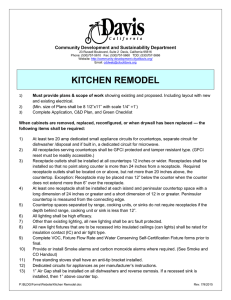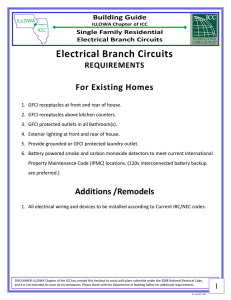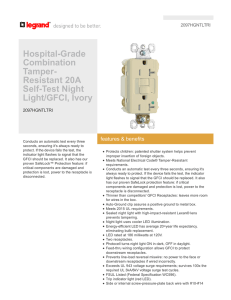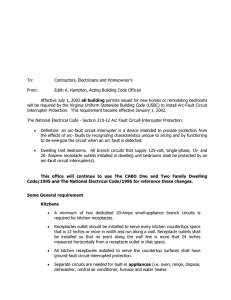homeowner electrical guide
advertisement
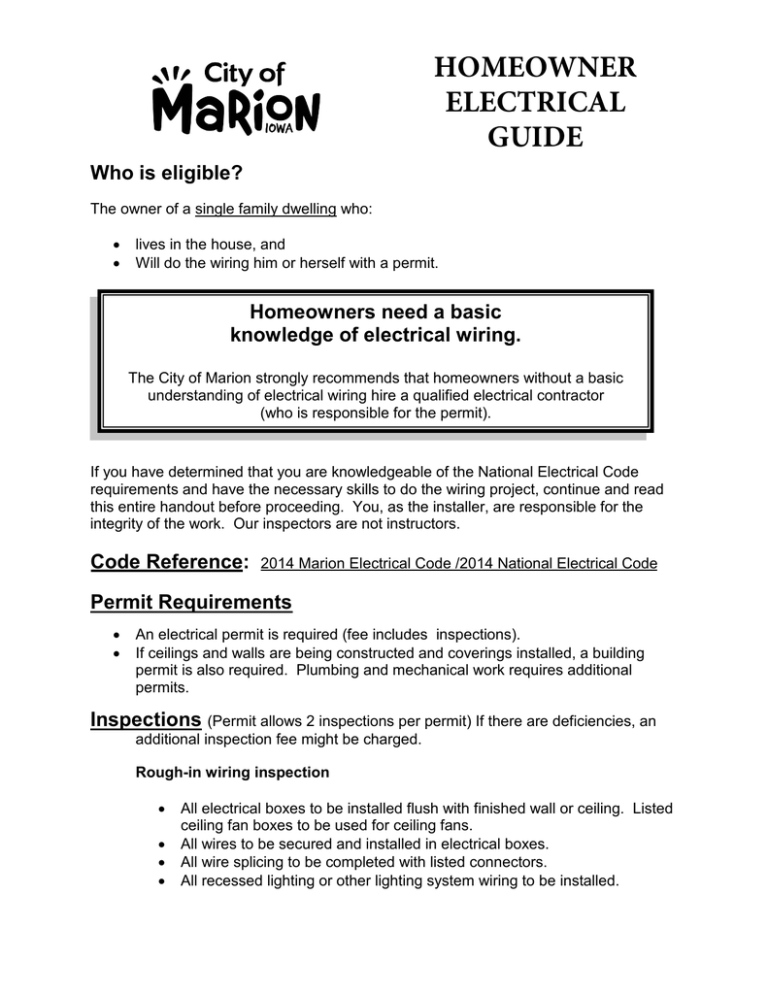
HOMEOWNER ELECTRICAL GUIDE Who is eligible? The owner of a single family dwelling who: • • lives in the house, and Will do the wiring him or herself with a permit. Homeowners need a basic knowledge of electrical wiring. The City of Marion strongly recommends that homeowners without a basic understanding of electrical wiring hire a qualified electrical contractor (who is responsible for the permit). If you have determined that you are knowledgeable of the National Electrical Code requirements and have the necessary skills to do the wiring project, continue and read this entire handout before proceeding. You, as the installer, are responsible for the integrity of the work. Our inspectors are not instructors. Code Reference: 2014 Marion Electrical Code /2014 National Electrical Code Permit Requirements • • An electrical permit is required (fee includes inspections). If ceilings and walls are being constructed and coverings installed, a building permit is also required. Plumbing and mechanical work requires additional permits. Inspections (Permit allows 2 inspections per permit) If there are deficiencies, an additional inspection fee might be charged. Rough-in wiring inspection • • • • All electrical boxes to be installed flush with finished wall or ceiling. Listed ceiling fan boxes to be used for ceiling fans. All wires to be secured and installed in electrical boxes. All wire splicing to be completed with listed connectors. All recessed lighting or other lighting system wiring to be installed. • • Do not install receptacles or switches. (Should you wish to install the devices to check your installation, please do not attach them to the boxes.) Cables may be installed in the electrical panels. (Shut off main power prior to removing the panel cover.) Keep new wires away from energized portions of the panel. Correction inspection (if required) • Any deficiencies noted by the inspector at the rough-in inspection will need to be re-inspected and approved. Final inspection • • • All devices and luminaries (fixtures) shall be installed. All branch circuits shall be terminated in the electrical panel and labeled. All smoke alarms and carbon monoxide detectors shall be installed and in working order. Installation Guidelines Electrical Panels 1. Electrical panels shall have clearances of 30” in width and 36”from the face of the panel. 2. Electrical panels are not to be installed in a closet, bathroom, or stairways. Outlet Boxes 1. Outlet boxes are to be installed flush with the finished wall or ceiling. 2. All metallic boxes are to be bonded with a green colored screw or listed clamp. 3. All switch boxes are to have a grounded conductor (neutral) installed. If there is access from an attic above, this conductor could be installed later should the device require a neutral. 4. Leave a minimum of 6” of wire measured from where the cable enters the box for joints and connection of equipment (minimum of 3” from front of box. 5. All junction boxes are to be accessible at all times. No box can be covered by wall or ceiling coverings. 6. Ceiling fans are to be installed on boxes “listed for ceiling fans”. 7. The outlet box for a hydro-massage tub shall be within 1 foot of the access opening. Non-metallic Cable (Romex®) 1. 14 AWG copper wire is minimum size wire for general purpose wiring (receptacles and luminaries (light fixtures). 2. Kitchen small appliance circuits are to be 20 ampere and wired with 12 AWG copper wire. 3. Over-current protection (fuse or circuit breaker) is to be properly sized to the gauge of the wire used. 4. All splices and joints are to be made in an accessible, outlet box or junction box with approved and listed connectors. 5. Where the electrical cable is run through studs, the holes should be a minimum of 1 ¼” back from the face of the stud or the cable is to be protected by a nail guard plate. For drilling guidelines, see “Drilling, notching, and cutting” brochure. 6. Cables are to be secured every 4 ½’ when run along side of a stud or joist. 7. Cable is to be secured within 8” of a single plastic outlet box and 12” of a 2 or more gang box. 8. Suggested number of outlets (lights and receptacles) on a 15amp general purpose circuit is 10 while a 20 amp circuit should have no more than 13. 9. A grounded (neutral) conductor is to be installed in all switch boxes. If there is access from an attic above where it could be installed at a later date, this does not need to be completed at this time. Receptacle Outlet Rules 1. All receptacle outlets below 5 ½ feet or behind an appliance are to be tamper resistant. 2. Exterior receptacles are to be both weather and tamper resistant. 3. Every finished room must have receptacles installed so no point on any wall is over 6’ from a receptacle. 4. A receptacle is required with 6’ of a doorway or fireplace and every 12’ apart if there are no breaks in the wall line. You should measure around corners. 5. A wall space 2’ or wider requires a receptacle. 6. A hallway 10’ or longer requires a receptacle. 7. A foyer measuring over 60 square feet is to have a receptacle located on each wall space 3 feet or more in width. 8. In a bathroom, a GFCI receptacle is required within 3’ of the edge of the basin. The bathroom receptacles are to be wired with a dedicated, 20 amp circuit. 9. All receptacles are to be grounded. 10. GFCI receptacles are to be readily accessible. 11. If more than one cable enters a receptacle box, the black, white, and ground wires are to be “pigtailed” with a connector and have a minimum of 3” of conductor outside the box for attachment to the device screws. Kitchen Receptacle Guidelines (Small appliance circuits) 1. Receptacles shall be placed so no point along the counter wall is over 24” from a receptacle. 2. A countertop 12” or more in width requires a receptacle. 3. All countertop receptacles are to be GFCI protected. 4. The countertop receptacles are to be supplied by a minimum of two 20ampere circuits. These 2 circuits may also feed the dining area and pantry receptacles. 5. Receptacles are not to be more than 20” above the countertop. 6. Permanently installed dishwashers/disposals and microwaves require dedicated appliance circuits. Ground-Fault Circuit Interrupter (GFCI) All GFCI’ receptacles are to be readily accessible. GFCI’s are required on the following 15 and 20 ampere, 120 volt receptacles in a dwelling unit: 1. 2. 3. 4. 5. 6. 7. 8. 9. All bathroom receptacles. All kitchen counter top receptacles. All receptacles within 6’ of a sink. Garages and accessory buildings (including overhead door operators). Outdoor receptacles. Crawl spaces. Unfinished areas of basements. Boathouses. Hydro-massage bath tubs, hot tubs, and spas. GFCI protection can be in the form of a breaker in the electrical panel or is to be a dead front (no receptacles) GFCI device readily accessible (access door opens easily without any tools) or place the GFCI out in the open in the bathroom. (Reference Article 680) Arch-fault breakers (combination type) are required on all circuits supplying power to habitable space outlets (lights, receptacles, smoke alarms). Arc fault breakers are not required for circuits supplying power to unfinished basements, bathrooms, kitchens, garages, or laundry rooms. Lighting Requirements 1. A wall switched lighting outlet must be installed in every habitable room, bathrooms, hallways, stairway, attached and detached garages with power. 2. In habitable rooms, other than kitchens and bathrooms, wall switched receptacles may be installed in place of a lighting outlet. 3. A wall switched lighting outlet must be installed at each outdoor entrance. 4. Attics, under-floor spaces, utility rooms, and basements shall have at least one lighting outlet installed. This electrical brochure is only a guide and does not cover all of the requirements. The homeowner performing electrical work is required to be familiar with the adopted National Electrical Code and its guidelines. We look forward to working with you on your next project. Dec 22, 2014
